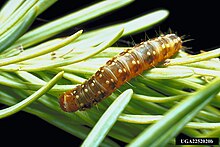Choristoneura fumiferana
| Choristoneura fumiferana | ||||||||||||
|---|---|---|---|---|---|---|---|---|---|---|---|---|

Choristoneura fumiferana |
||||||||||||
| Systematics | ||||||||||||
|
||||||||||||
| Scientific name | ||||||||||||
| Choristoneura fumiferana | ||||||||||||
| Clemens , 1865 |
Choristoneura fumiferana is a North American butterfly species from the genus Choristoneura within the family of the tortoiseshell (Tortricidae).
description
The wings are grayish in color and have dark brown markings. Occasionally animals with brown to reddish wings and dark brown markings also appear. Adult moths reach a wingspan of up to two centimeters. Males and females are the same size. The light green eggs are around 1 × 0.2 millimeters in size. The caterpillars go through a total of six larval stages. In the first larval stage, they are up to 2 millimeters long and yellowish-green in color with a light to medium brown head. In the second larval stage, they are yellow with a dark brown or black head. During the next four larval stages, the caterpillar changes color from a light yellow to a dark brown with light spots on its back. In the sixth larval stage, the caterpillar is around 2.5 centimeters long and has a dark brown to shiny black head. The pupa is initially pale green and later turns a reddish brown.
distribution
The distribution area of the butterfly overlaps with that of its forage plants. It occurs in Canada and the eastern United States . The species is most commonly found in the US states of New Hampshire , New York , Maine , Michigan , Minnesota and Wisconsin .
Way of life
The oligophagous caterpillars feed mainly on the balsam fir ( Abies balsamea ), the white spruce ( Picea glauca ) and the American red spruce ( Picea rubens ), other conifers are more rarely attacked. The caterpillars mine the needles, buds and male cones. One generation is trained every year. Some populations have a 2 year life cycle. The eggs are laid on branches in piles of 2 to 60 pieces, overlapping each other. The caterpillars hatch after around 2 weeks. The newly hatched caterpillars overwinter under the bark or in other protected places. In the following year the caterpillars are found from May to July. In late June and July, the caterpillars stop feeding and begin to pupate on the coniferous bases of the forage trees. The fully developed butterflies hatch after around 10 days.
Harmful effect
The caterpillar is one of the most important pests in the northern coniferous forests of North America . In the event of an infestation, the host trees first lose their needles in the crown area. Trees with heavy infestation usually die after a year.
Combat
Choristoneura fumiferana has a high reproductive rate, but natural factors such as bad weather, disease, parasites and predators play an important role in population control. The caterpillars are attacked by the brackish wasp Meteorus trachynotus , the parasitic wasp Phaeogenes hariolus and the fly Lypha setifacies . If there is enough forage and good weather conditions, there can still be mass reproductions that require the use of biological or chemical insecticides . Biological control with viruses would be around 30 times more expensive than using chemical insecticides. The Microspora Perezia fumiferanae slows the growth of the caterpillars and pupae and shortens the life span of the moths.
Systematics
The following synonyms are known from the literature :
- Tortrix nigrida Beutenmüller , 1892
- Tortrix nigridia Robinson , 1869
swell
- Daniel R. Kucera and Peter W. Orr: Spruce Budworm in the Eastern United States. Forest Insect & Disease Leaflet, 160: US Department of Agriculture Forest Service (undated) full text (Engl.)
credentials
- ↑ a b c d e f Spruce Budworm in the Eastern United States
- ↑ a b entry at Forestpests.org
- ↑ John W. Brown: Tortricidae. In: World Catalog of Insects. Volume 5 , Apollo Books, 2005, ISBN 87-88757-41-2 . online: http://www.tortricidae.com/catalogueSpeciesList.asp?spcode=1976

